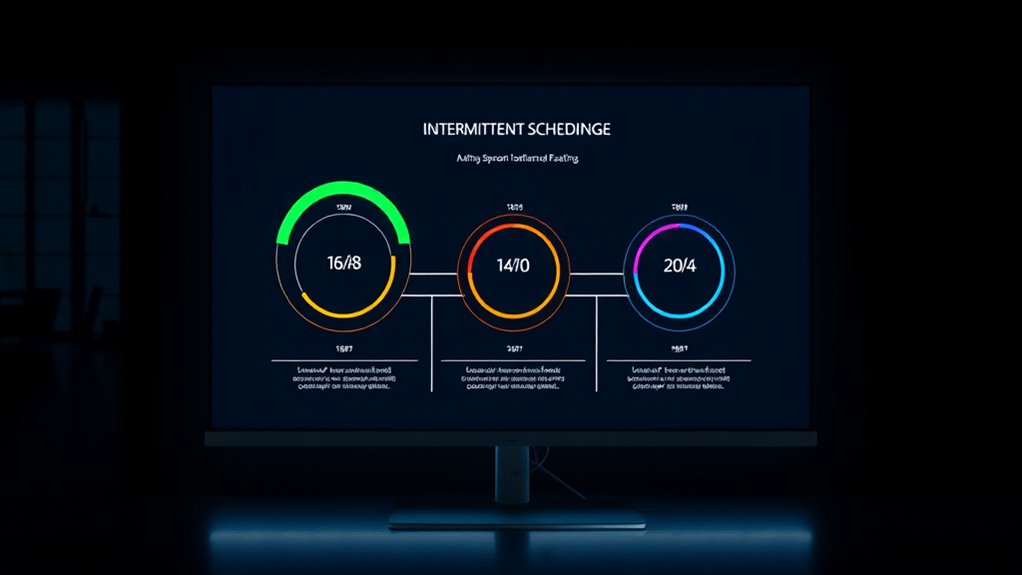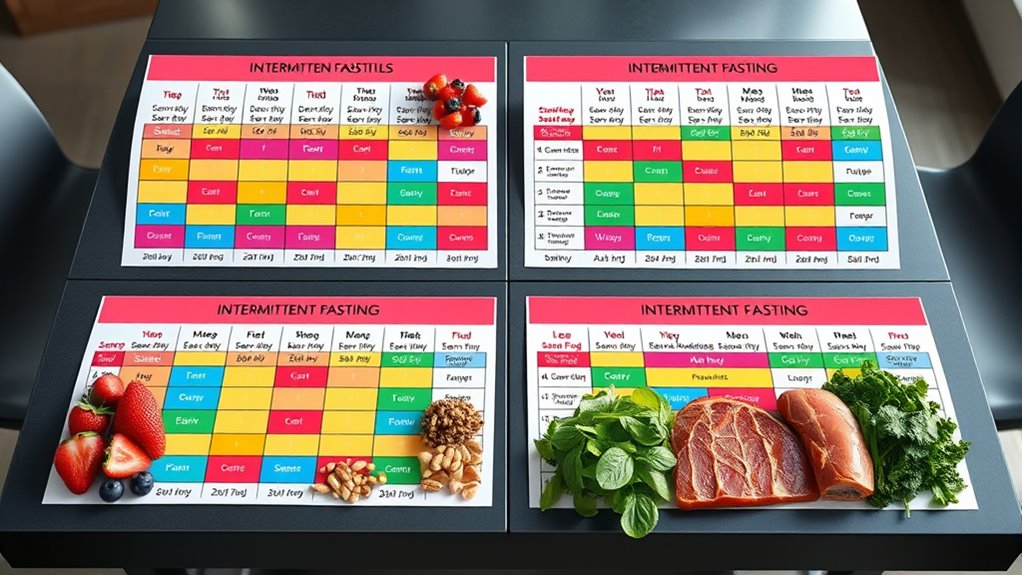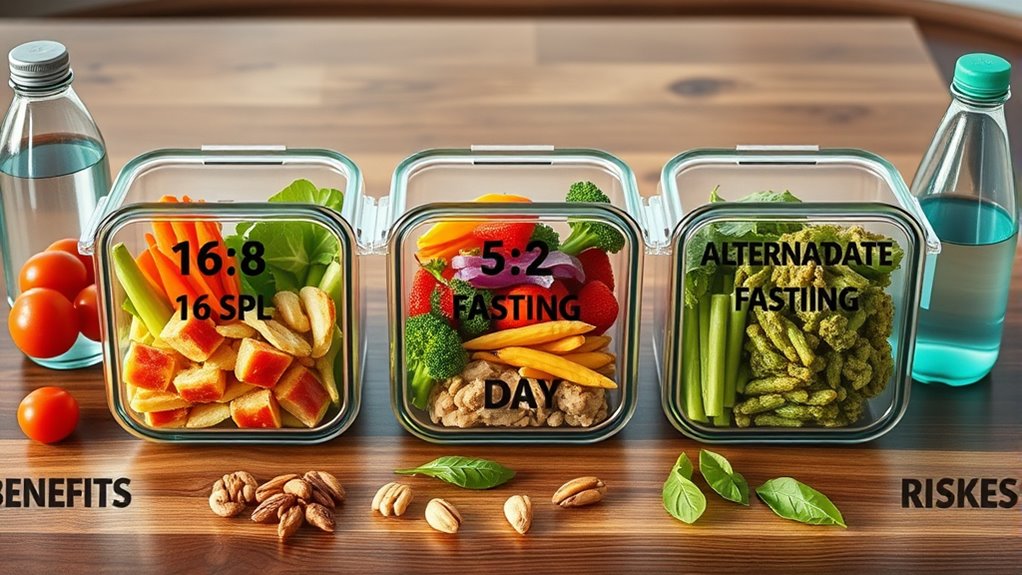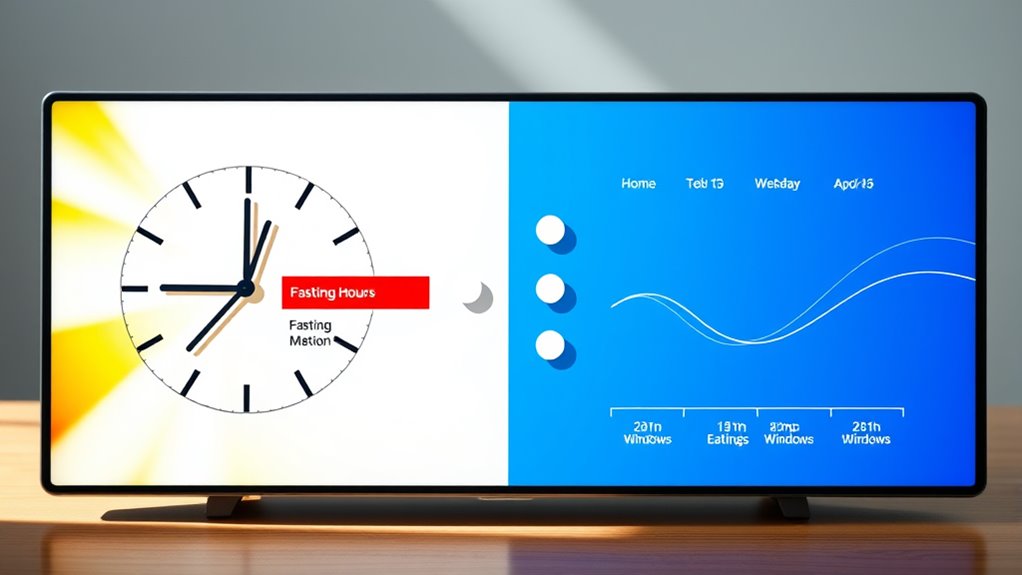Intermittent fasting schedules vary from time-restricted eating, like 16:8 or 14:10, to calorie-restriction plans such as 5:2 or alternate-day fasting. Time-restricted methods are easy to fit into daily routines and promote consistency, while calorie-restriction diets focus on limiting intake on specific days. Each approach offers unique benefits and challenges, so exploring their differences helps you find the most sustainable option. If you’re curious about how these schedules compare, keep exploring for more insights.
Key Takeaways
- Time-restricted eating (e.g., 14:10, 16:8) involves daily fasting windows, offering simplicity and routine integration.
- Alternate-day fasting alternates fasting and regular eating days, providing significant calorie deficit but less social flexibility.
- The 5:2 diet allows two non-consecutive fasting days weekly, balancing restriction with ease of adherence.
- Longer fasts (>24 hours) may intensify weight loss but pose higher risks and require careful planning.
- Fasting schedules vary in flexibility, impact on adherence, and health benefits, making personalized choice essential.
Time-Restricted Eating Patterns

Have you ever wondered how the timing of your meals affects your health? Time-restricted eating (TRE) typically involves a daily fasting period of 4 to 12 hours, with most studies focusing on 6 to 10 hours. Many adults, however, eat over a much longer window, often exceeding 14 hours. Restricting eating to an 8–10 hour window can lead to modest health improvements, like better insulin sensitivity and weight loss, without calorie counting. Shorter windows under 8 hours may increase cardiovascular risk, especially for those with existing health issues. Aligning your eating schedule with your circadian rhythms—like eating earlier in the day—can boost metabolic health. Incorporating digital literacy into health education can help individuals better understand and implement effective fasting routines. Being aware of spoiled lemon juice signs can prevent health risks associated with consuming spoiled food. Overall, sticking to a consistent, shorter eating window supports better health outcomes and simplifies your daily routine.
Calorie Restriction Diets

Calorie restriction diets focus on reducing your daily calorie intake while still getting essential nutrients. You can follow various patterns, like alternate-day fasting or the 5:2 diet, to suit your lifestyle. Staying consistent and balancing your food choices are key to maintaining these diets effectively. Incorporating a clear budget for your food expenses can help you stick to your calorie goals more efficiently. Additionally, understanding potential pitfalls in adopting new payment technologies can help you make informed decisions when planning your dietary changes. Engaging in aquatic exercise can also support your weight management efforts by providing a low-impact way to increase activity levels. Exploring grocery savings strategies can further help you maintain a sustainable diet by reducing overall food costs.
Calorie Intake Patterns
Calorie restriction diets center on consistently reducing your daily caloric intake to promote weight loss and enhance health. By creating a calorie deficit, your body burns more calories than it consumes, leading to weight loss. This approach can be achieved through various methods, like daily calorie reduction or calorie shifting, which alternates between high and low intake days. Here are some key points to consider:
- Consistency is vital for long-term success.
- Managing intake prevents metabolic slowdown.
- Different approaches suit different lifestyles and preferences.
- Proper planning ensures nutritional balance while restricting calories.
- Incorporating diverse designs in meal planning can help maintain engagement and adherence to the diet. Additionally, understanding how to balance calorie restriction with nutritional needs is crucial for avoiding deficiencies and maintaining overall health.
While effective, calorie restriction may decrease your resting metabolic rate if not carefully managed. Choosing the right pattern depends on your goals, lifestyle, and ability to stick with the plan.
Adherence Factors
Adherence to calorie restriction diets depends on a combination of motivation, psychological factors, and supportive environments. High motivation boosts compliance, but it can fade without ongoing support. Behavioral interventions like regular dietitian meetings considerably improve adherence. Psychological burdens and perceived difficulty can cause dropouts. Ensuring readiness and motivation before starting helps maintain commitment. Providing fully prepared, calorie-controlled foods at no cost or through home delivery makes sticking easier. When you self-select foods at home, adherence often drops. External factors like access to diet-friendly foods or social influences can hinder progress. Support from healthcare providers and monitoring tools also enhance compliance. Simplifying diet routines and reducing restrictions improves your chances of long-term success. Additionally, participating in structured programs like Hackathons can foster motivation and innovation, which may indirectly support healthy lifestyle changes. Incorporating exfoliation techniques such as glycolic acid can improve skin health, boosting confidence during weight management journeys. Recognizing the importance of motivation maintenance strategies helps sustain long-term commitment to calorie restriction. Moreover, understanding how lifestyle factors influence eating habits can further strengthen adherence efforts.
Nutritional Balance
Maintaining nutritional balance is essential when following calorie restriction diets, as reducing your intake must still meet your body’s crucial nutrient needs. You need to focus on nutrient-dense foods that provide essential vitamins, minerals, and antioxidants within a limited calorie budget. To ensure proper nutrition, consider these key points:
- Prioritize fruits, vegetables, lean proteins, nuts, and whole grains to maximize nutrient intake.
- Limit processed foods, sugary drinks, and refined carbs that offer calories but lack vital nutrients.
- Monitor macronutrients like protein to preserve muscle and support metabolism.
- Supplement if necessary, especially for micronutrients like calcium, iron, and vitamins that might be harder to obtain on a calorie-restricted plan.
- Incorporate Self Watering Plant Pots to maintain a consistent moisture level in your home garden, which can be especially helpful when busy or traveling, ensuring plants stay healthy without frequent watering.
Fasting Regimens for Weight Loss

When choosing a fasting regimen for weight loss, you’ll want to consider how simple it is to control your calorie intake and stay consistent. Flexibility in your schedule can make it easier to stick with the plan long-term, while metabolic health benefits like improved insulin sensitivity boost your results. Finding an approach that fits your lifestyle helps ensure you stay committed and see real progress. Incorporating modern shower fixtures can also enhance your bathroom experience, making your home more comfortable and efficient. Additionally, selecting a regimen that aligns with juice recipes and mixes can help support your nutritional goals during fasting periods. Monitoring market trends and insights related to health and wellness can also help you stay motivated and informed about new fasting strategies. Understanding tuning upgrades and how they optimize performance can serve as a motivational analogy for making sustainable lifestyle changes. Recognizing the importance of fatherly guidance and support can further reinforce your commitment to healthy habits.
Calorie Control Strategies
Have you ever wondered how different fasting regimens help control calorie intake for weight loss? Calorie control is key, and intermittent fasting manages this in various ways.
- It reduces calorie intake on fasting days, often limiting you to 500-600 calories with nutrient-dense foods.
- Some schedules, like the 4:3 plan, allow normal eating on non-fasting days, balancing restriction and sustainability.
- Alternate-day fasting alternates between regular eating and low-calorie days, creating a significant calorie deficit.
- Compared to daily calorie restriction, IF can lead to greater weight loss over time, especially when combined with nutrient-rich choices.
- Utilizing meal planning and tracking tools can optimize your fasting regimen and ensure proper nutrient intake.
Adherence and Flexibility
Adherence and flexibility are crucial factors that influence the success of different fasting regimens for weight loss. With the 4:3 method, you get to enjoy four days of normal eating, making it easier to stick with socially and professionally. The 5:2 plan offers non-consecutive fasting days, allowing you to adapt based on your schedule. Time-restricted eating, like 14:10 or 16:8, fits seamlessly into daily routines, reducing decision fatigue. However, alternate-day fasting can be less adaptable, often harder to maintain socially. Adjusting fasting days and eating windows according to your preferences helps improve adherence. Regimens that minimize psychological burden and provide routine simplify sticking to your goals, especially with social support and education about the flexibility options available. Incorporating best keto oils for frying and suitable vegetables can support dietary consistency and overall health during fasting periods. Additionally, understanding the various fasting schedules can help you choose a plan that aligns with your lifestyle and enhances long-term compliance. Moreover, integrating insights from breakfast delivery trends—such as health-conscious options and convenience—can make meal planning more flexible and appealing during fasting or feeding windows. Being aware of store hours for beauty retailers can also help plan shopping trips efficiently around your fasting schedule, and considering individual personality traits can influence the best fasting approach suited to your lifestyle.
Metabolic Health Benefits
Intermittent fasting not only simplifies your eating schedule but also offers significant metabolic health benefits that support weight loss. It encourages your body to switch from glucose to fat burning, promoting fat loss and improving your metabolic profile. You may find it easier to stick with, as some studies show better adherence compared to continuous calorie restriction. Here are four key benefits:
- Reduces insulin resistance, improving glucose regulation.
- Enhances insulin sensitivity and glucose metabolism.
- Balances hormones like leptin and adiponectin, controlling hunger and fat storage.
- Aligns meal timing with circadian rhythms, optimizing nutrient use and energy expenditure.
Together, these effects help you lose weight more effectively while supporting overall metabolic health and reducing risks for type 2 diabetes and cardiovascular issues.
Balancing Adherence and Nutritional Needs

Balancing adherence and nutritional needs is essential to making intermittent fasting sustainable and effective. The 16/8 method often leads to better compliance because of its shorter fasting window, while the 5:2 approach offers flexibility by allowing normal eating most days, reducing psychological strain. The 4:3 protocol, with three low-calorie days weekly, shows promising weight loss and adherence results, outperforming daily calorie restriction. To stay nourished, focus on high-protein, fiber-rich meals early in your eating window, and hydrate well with water and electrolyte drinks. Incorporate nutrient-dense foods like leafy greens and nuts, and consider multivitamins if fasting extends. Mindful meal planning, pre-portioned dishes, and social flexibility support consistency, helping you meet your nutritional needs without overcompensating during feeding periods.
Potential Health Benefits and Risks

Understanding the potential health benefits and risks of intermittent fasting helps you make informed decisions about its suitability for your goals. While IF can support weight loss by reducing calorie intake and improving metabolism, it may also lower insulin resistance and boost cellular repair, possibly promoting longevity. However, some patterns, like an 8-hour eating window, have been linked to a 91% higher risk of cardiovascular death, and certain fasting cycles might increase heart disease risk for some people.
- You could experience side effects like dizziness, headaches, or mood swings.
- Muscle loss, especially in older adults, might weaken your bones and immune system.
- Overeating on non-fasting days can negate benefits and cause weight gain.
- Nutritional deficiencies may arise if your diet isn’t well-balanced during eating windows.
Choosing the Right Fasting Schedule

Choosing the right fasting schedule depends on your daily routine, meal preferences, and exercise habits. Pick a plan that fits seamlessly into your lifestyle to stay consistent. Flexibility is essential—listen to your hunger cues and adjust meal timing when needed. For example, if you prefer late-night dinners, a 14:10 schedule might work better than 16:8. Your exercise routine also influences your choice; if you exercise in the mornings, plan your fasting around that to maintain energy. Popular methods like 16:8, 14:10, or 5:2 offer different levels of flexibility. Focus on nutrient-dense foods, stay hydrated, and include healthy fats for satiety. Remember, the key is to choose a schedule you can sustain long-term, adapting it as your needs evolve.
Frequently Asked Questions
Can Intermittent Fasting Be Safely Combined With Other Diets?
You can safely combine intermittent fasting with other diets if you pay attention to your body’s signals. Focus on balanced, nutrient-dense meals during eating windows, and consult a healthcare provider if you have health conditions or are pregnant. Stay hydrated, avoid extreme restrictions, and listen to how you feel. Moderation is key. When done responsibly, combining fasting with a suitable diet can support your health and weight management goals.
How Does Fasting Affect Athletic Performance and Muscle Mass?
Fasting impacts your athletic performance and muscle mass in various ways. You might see improvements in VO2 max with time-restricted feeding, but fasting during exercise can reduce endurance. Maintaining muscle depends on adequate protein intake, even during restricted windows. Fat loss is common, especially in athletes with higher body fat. To preserve muscle and performance, focus on nutrient quality, timing, and individual responses, adjusting your approach as needed.
Are There Age Restrictions for Starting Intermittent Fasting?
You’re wondering about age restrictions for starting intermittent fasting. Generally, it’s not recommended for those under 18 because of growth concerns. Older adults, especially over 80, should proceed with caution and consult their doctor, especially if they have chronic health issues. Pregnant or breastfeeding women and individuals with eating disorders shouldn’t fast. Always verify with a healthcare professional before beginning, to ensure it’s safe for your specific age and health condition.
What Are the Effects of Fasting on Hormonal Health?
Imagine you start fasting and notice changes in your hormones. Fasting boosts growth hormone, aiding fat burning, and lowers insulin, improving blood sugar. In women, it can reduce testosterone and androgen markers, helping balance hormones but possibly affecting menstrual cycles. In men, it might slightly decrease testosterone without harming strength. Overall, fasting influences your hormonal health by balancing metabolism, but monitor your body’s responses to avoid imbalances.
How Should Fasting Schedules Be Adjusted for Chronic Health Conditions?
You should tailor your fasting schedule based on your specific chronic health condition. For diabetes, monitor blood sugar closely and opt for shorter fasts or modified routines. If you have cardiovascular concerns, focus on fasting that supports blood pressure and cholesterol, avoiding prolonged fasts. For inflammatory or neurological issues, work with a healthcare professional to design a plan that reduces risks and enhances benefits, ensuring proper nutrient intake and safety.
Conclusion
Choosing the right fasting schedule is like finding the perfect key to unseal your health goals. It’s about balancing what fits your lifestyle with your body’s needs, turning fasting from a challenge into a steady companion. Remember, no one-size-fits-all. Listen to your body, stay flexible, and enjoy the journey—your health is a garden that flourishes with the right care. Trust yourself, and watch your well-being blossom like a springtime garden.









